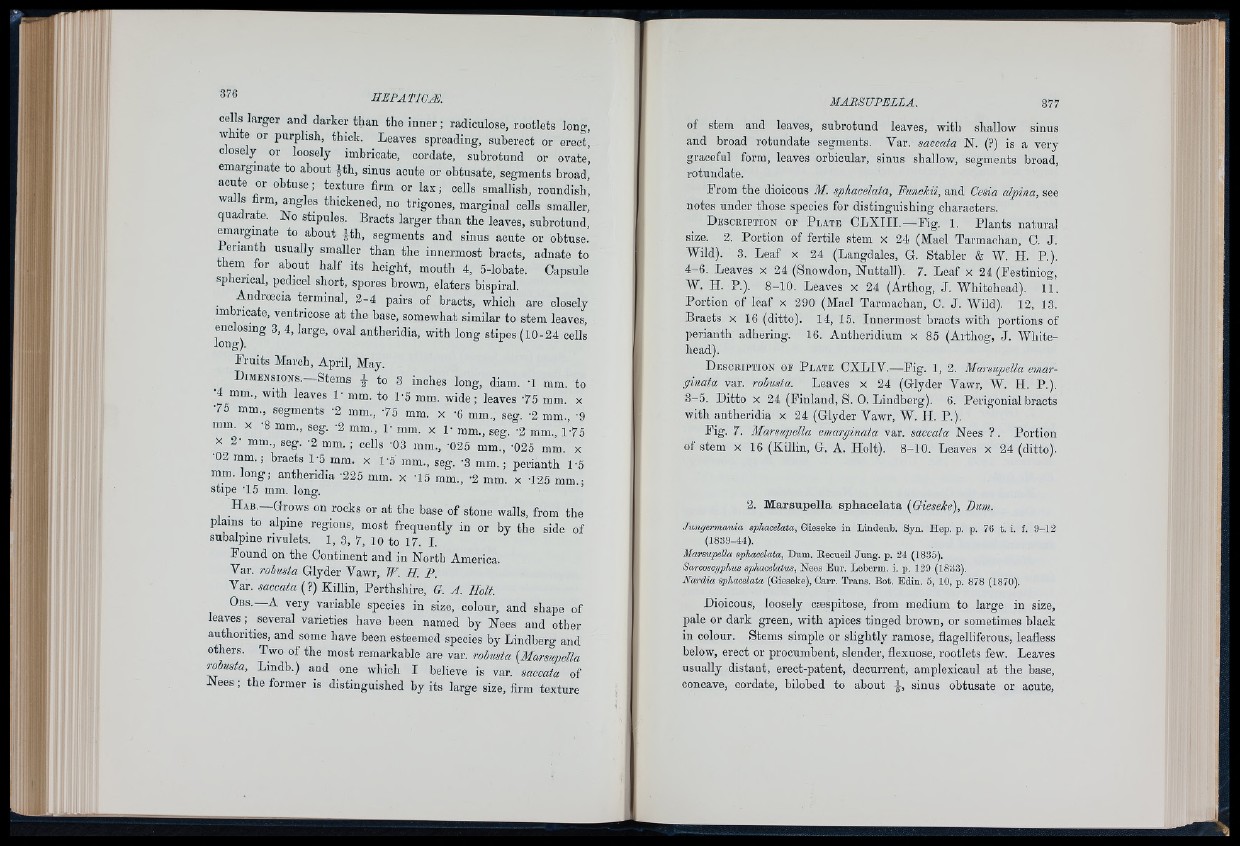
cells larger and darker than the inner ; radiculose, rootlets lono-,
white or purplish, thick. Leaves spreading, suberect or erect,
closely or loosely imbricate, cordate, suhrotund or ovate,
emarginate to about |th , sinus acute or obtusate, segments broad,
acute or obtuse; texture firm or lax; cells smallish, roundish’,
walls firm, angles thickened, no trigones, marginal cells smaller,
quadrate. No stipules. Bracts larger than the leaves, suhrotund,
emarginate to about ¿th, segments and sinus acute or obtuse.
Perianth usually smaller than the innermost bracts, adnate to
them for about half its height, mouth 4, 5-lobate. Capsule
spherical, pedicel short, spores brown, elaters bispiral.
Androecia terminal, 2-4 pairs of bracts, which are closely
imbricate, ventricose at the base, somewhat similar to stem leaves,
enclosing 3, 4, large, oval antheridia, with long stipes (10-24 cells
long).
Fruits March, April, May.
D imensions.— Stems J to 3 inches long, diam. T mm. to
4 mm., with leaves 1‘ mm. to lA mm. wide; leaves '75 mm. x
•75 mm., segments -2 mm., 75 mm. x A mm., seg. -2 mm., A
mm. X -8 mm., seg. -2 mm., 1- mm. x I ’ ram., seg. ’2 mm., 175
X 2- mm., seg. '2 mm. ; cells AS mm., -025 mm., A25 mm. x
02 mm.; bracts lA mm. x lA mm., seg. ’3 mm.; perianth lA
mm. long; antheridia '225 mm. x -15 mm„ -2 mm. x -125 mm.;
stipe T5 mm. long.
H ab.—Grows on rocks or at the base of stone walls, from the
plains to alpine regions, most frequently in or by the side of
subalpine rivulets. 1, 3, 7. 10 to 17. I.
Found on the Continent and in North America.
Var. robusta Glyder Vawr, JV. II. P.
Var. saccata (?) Killin, Perthshire. G. A. Holt.
Obs.— A very variable species in size, colour, and shape of
leaves ; several varieties have been named hy Nees and other
authorities, and some have been esteemed species by Lindberg and
others. Two of the most remarkable are var. robusta {Marsupella
robusta, Lindb.) and one which I believe is var. saccata of
Nees ; the former is distinguished by its large size, firm texture
of stem and leaves, subrotund leaves, with shallow sinus
and broad rotundate segments. Var. saccata N. (?) is a very
graceful form, leaves orbicular, sinus shallow, segments broad,
rotundate.
From the dioicous M. sphacelata, Funckii, and Cesia alpina, see
notes under those species for distinguishing characters.
D escription of P late C LX III.—Fig. 1. Plants natural
size. 2. Portion of fertile stem x 24 (Mael Tarmachan, C. J.
Wild). 3. Leaf x 24 (Langdales, G. Stabler & W. H. P.).
4-6. Leaves x 24 (Snowdon, Nuttall). 7. Leaf x 24 (Festiniog,
W. H. P.). 8-10. Leaves x 24 (Arthog, J. Whitehead). 11.
Portion of leaf x 290 (Mael Tarmachan, C. J. Wild). 12, 13.
Bracts x 16 (ditto). 14, 15. Innermost bracts with portions of
perianth adhering. 16. Antheridium x 85 (Artliog, J. Whitehead).
D escription oe P late CXLIV.—Fig. 1, 2. Marsupella emar-
ffinata var. robusta. Leaves x 24 (Glyder Vawr, W. H. P.).
3-5. Ditto X 24 (Finland, S. 0. Lindberg). 6. Perigonial bracts
with antheridia x 24 (Glyder Vawr, W. II. P.).
Pig. 7. Marsupella emaryinata var. saccata Nees ? . Portion
of stem X 16 (Killin, G. A. Holt). 8-10. Leaves x 24 (ditto).
2. Marsupella sphacelata (Gieseke), Bum.
Jungermania sphacelata, Gieseke in Lindenb. Syn. Hep. p. p. 76 t. i, f. 9-12
(1839-44).
Uarsupdla sphacelata, Dum. Recueil Jung. p. 24 (1835).
Sarcoscyphus sphacelatus, Nees Eur. Leberm. i. p. 129 (1833).
Nardia sphacelata (Gieseke), Carr, Trans. Bot, Edin. 5, 10, p. 878 (1870).
Dioicous, loosely cæspitose, from medium to large in size,
pale or dark green, with apices tinged brown, or sometimes black
in colour. Stems simple or slightly ramose, flagelliferous, leafless
below, erect or procumbent, slender, flexuose, rootlets few. Leaves
usually distant, erect-patent, decurrent, amplexicaul at the base,
concave, cordate, bilobed to about sinus obtusate or acute,